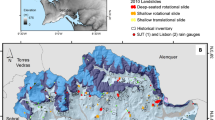Abstract
Rainfall and slope cutting are the most important inducing factors of landslide activities in Southwest China. This paper takes the Simiqiao landslide in Wushan County, Chongqing as an example, obtains the stability and stress–strain field of the landslide under different conditions by field investigation and numerical simulation analysis and further analyzes the influence of rainfall and slope cutting on the stability of the Simiqiao landslide. The conclusions are as follows: the slope cutting has a great influence on the stability of the landslide. For the typical profile, the cutting slope condition under saturated state (coupling condition of rainfall and slope cutting) has the worst stability with a safety factor of 0.886, followed by the cutting slope condition under natural state with a safety factor of 0.939. In this paper, the prevention and control measures for the Simiqiao landslide are also put forward. The research results can provide a reliable reference for disaster prevention and mitigation of similar landslides.












Similar content being viewed by others
References
Baum RL, Godt JW (2010) Early warning of rainfall-induced shallow landslides and debris flows in the USA. Landslides 7(3):259–272
Chen XD, Guo HX, Song EX (2008) Analysis method for slope stability under rainfall action. Landslides Eng Slopes 1:1507–1515
Chen XL, Wang MM, Zhang L (2018) Numerical simulation of the influence of road excavation position on slope stability. Seismogeology 40(6):1390–1401 (in Chinese)
Dai ZW, Li B, Chen YX et al (2016) Study on the mechanism of landslide rainstorm instability in the accumulation layer of Dashuchang Town, Three Gorges. Hydrogeol Eng Geol 43(1):149–156 (in Chinese)
Dai ZW, Zhang CY, Wang L et al (2021) Interpreting the influence of rainfall and reservoir water level on a large-scale expansive soil landslide in the Danjiangkou Reservoir region China. Eng Geol 11:106–110
Gao Y, Yin YP, Li B et al (2017) Characteristics and numerical runout modeling of the heavy rainfall-induced catastrophic landslide–debris flow at Sanxicun, Dujiangyan, China, following the Wenchuan Ms 8.0 earthquake. Landslides 14(4):1361–1374
Hou TS, Wang XG, Pamukcu S (2016) Geological characteristics and stability evaluation of Wanjia middle school slope in Wenchuan earthquake area. Geotech Geol Eng 34(1):237–249
Huang RQ (2007) Large-scale landslides and their occurrence mechanism in China since 20th century. J Rock Mech Eng 26(3):433–454 (in Chinese)
Liao ZH, Hong Y, Wang J et al (2010) Prototyping an experimental early warning system for rainfall-induced landslides in Indonesia using satellite remote sensing and geospatial datasets. Landslides 7(3):317–324
Sari M (2019) Stability analysis of cut slopes using empirical, kinematical, numerical and limit equilibrium methods: case of old Jeddah-Mecca road (Saudi Arabia). Environ Earth Sci 78(21):1–25
Technical Guidance Center for Geological Disasters, Ministry of Natural Resources. National Geological Disasters Bulletin (2019 edition) (2020) (in Chinese)
Tu XB, Kwong AKL, Dai FC et al (2009) Field monitoring of rainfall infiltration in a loess slope and analysis of failure mechanism of rainfall-induced landslides. Eng Geol 105(1):134–150
Wang JJ, Liang Y, Zhang HP et al (2014) A loess landslide induced by excavation and rainfall. Landslides 11(1):141–152
Wang LQ, Yin YP, Huang BL et al (2019a) Formation and characteristics of Guang’an Village landslide in Wuxi, Chongqing. China Landslides 16(1):127–138
Wang LQ, Yin YP, Zhang ZH et al (2019b) Stability analysis of the Xinlu Village landslide (Chongqing, China) and the influence of rainfall. Landslides 16(10):1993–2004
Xu Q, Fan XM, Huang RQ et al (2009) A catastrophic rockslide-debris flow in Wulong, Chongqing, China in 2009: background, characterization, and causes. Landslides 7(1):75–87
Xu L, Dai FC, Tham LG et al (2011) Field testing of irrigation effects on the stability of a cliff edge in loess, North-West China. Eng Geol 120(1):10–17
Xu X, Xing YC, Guo Z et al (2021) Stability analysis of rainfall-triggered toe-cut slopes and effectiveness evaluation of pile-anchor structures. J Earth Sci 32(5):1104–1112
Yan GQ, Yin YP, Huang BL et al (2019) Formation mechanism and characteristics of the Jinjiling landslide in Wushan in the Three Gorges Reservoir region, China. Landslides 16(11):2087–2101
Yang XY, Fu J, Han XD et al (2021) Progress of geological hazards survey in the urban area from Wushan in the Three Gorges Reservoir. China Geol Surv 8(1):97–107 (in Chinese)
Yin YP, Huang BL, Zhang Q et al (2020) Research on recently occurred reservoir-induced Kamenziwan rockslide in Three Gorges Reservoir China. Landslides 17(2):1935–1949
Zhang M, Yin YP, Huang BL (2015) Mechanisms of rainfall-induced landslides in gently inclined red beds in the eastern Sichuan Basin, SW China. Landslides 12(5):973–983
Zhang CY, Yin YP, Dai ZW et al (2021) Reactivation mechanism of a large-scale ancient landslide. Landslides 18(1):397–407
Zhuang JQ, Peng JB (2014) A coupled slope cutting—a prolonged rainfall-induced loess landslide: a 17 October 2011 case study. Bull Eng Geol Env 73(4):997–1011
Acknowledgements
The authors would like to thank Hai Li, Dan Luo and Peng Jin from 208 Geological Team, Chongqing, for their great assistance in the field investigation data.
Funding
The work is supported by funding from the Open Research Foundation of Hubei Key Laboratory of Disaster Prevention and Mitigation (China Three Gorges University) (Grant No. 2021KJZ02), the Natural Science Foundation of Hubei Province (Grant No. 2020CFB352), a follow-up of the Geological Disaster Prevention and Control Project in the Three Gorges area (Grant No. 000121 2019C C60 001 and Grant No. 000121 2021C C60 001).
Author information
Authors and Affiliations
Corresponding author
Ethics declarations
Conflict of interest
The authors declare that they have no competing interests.
Additional information
Responsible Editor: Zeynal Abiddin Erguler
Rights and permissions
Springer Nature or its licensor holds exclusive rights to this article under a publishing agreement with the author(s) or other rightsholder(s); author self-archiving of the accepted manuscript version of this article is solely governed by the terms of such publishing agreement and applicable law.
About this article
Cite this article
Zhang, A., Zhang, P., Dai, Z. et al. Failure mechanism of the Simiqiao landslide under rainfall and slope cutting. Arab J Geosci 15, 1432 (2022). https://doi.org/10.1007/s12517-022-10698-y
Received:
Accepted:
Published:
DOI: https://doi.org/10.1007/s12517-022-10698-y




